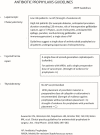Perioperative Antibiotic Prophylaxis: An Educative Intervention Significantly Increases Compliance
- PMID: 33854657
- PMCID: PMC8016525
- DOI: 10.14740/jocmr4447
Perioperative Antibiotic Prophylaxis: An Educative Intervention Significantly Increases Compliance
Abstract
Background: Implementation of guidelines in daily clinical practice is often suboptimal, mainly due to doctors' poor compliance with them. Perioperative antibiotic prophylaxis (PAP) is many times administered in patients undergoing elective surgery without proper indication or for longer time than needed. Aim of this study is to investigate the effect of a simple intervention on the compliance of the medical staff with the American Society of Health-System Pharmacists (ASHP) guidelines concerning PAP administration.
Methods: A prospective 3-month audit took place including routine surgical procedures (laparoscopic cholecystectomy, inguinal hernia repair and thyroidectomy). An intervention aiming to educate the medical staff was implemented. The intervention included the demonstration of a poster and the training of the medical staff over the guidelines. A re-audit recorded the changes in daily clinical practice.
Results: The compliance rate regarding the number of PAP doses significantly increased from 0% before the intervention to 68.8% after the intervention for hernia repair and to 53.1% for laparoscopic cholecystectomy. The adherence rate in thyroidectomies increased from 25% to 50%, but without statistical significance. No significant difference was found for other parameters of PAP administration, namely the type of antibiotic used and the timing of the dose administration. Regarding secondary outcomes, hospitalization days were reduced, and cost of antibiotics was significantly decreased (P < 0.05).
Conclusions: A simple intervention intending to educate the medical staff was successful in achieving significant improvement on the compliance rate with the PAP guidelines, highlighting the importance of promoting adherence to the already existing, well-established guidelines.
Keywords: Antibiotic prophylaxis; Compliance; Intervention; Surgical site infection.
Copyright 2021, Martzivanou et al.
Conflict of interest statement
None to declare.
Figures
References
-
- World Health Organization. WHO Report on Surveillance of antibiotic consumption: 2016-2018 early implementation. Geneva; 2018.
-
- Cassini A, Hogberg LD, Plachouras D, Quattrocchi A, Hoxha A, Simonsen GS, Colomb-Cotinat M. et al. Attributable deaths and disability-adjusted life-years caused by infections with antibiotic-resistant bacteria in the EU and the European Economic Area in 2015: a population-level modelling analysis. Lancet Infect Dis. 2019;19(1):56–66. doi: 10.1016/S1473-3099(18)30605-4. - DOI - PMC - PubMed
-
- Pollack LA, Plachouras D, Gruhler H, Sinkowitz-cochran R. Transatlantic Taskforce on Antimicrobial Resistance (TATFAR) Summary the modified Delphi process for common structure and process indicators for hospital antimicrobial stewardship programs. 2015.
LinkOut - more resources
Full Text Sources
Other Literature Sources
Research Materials

